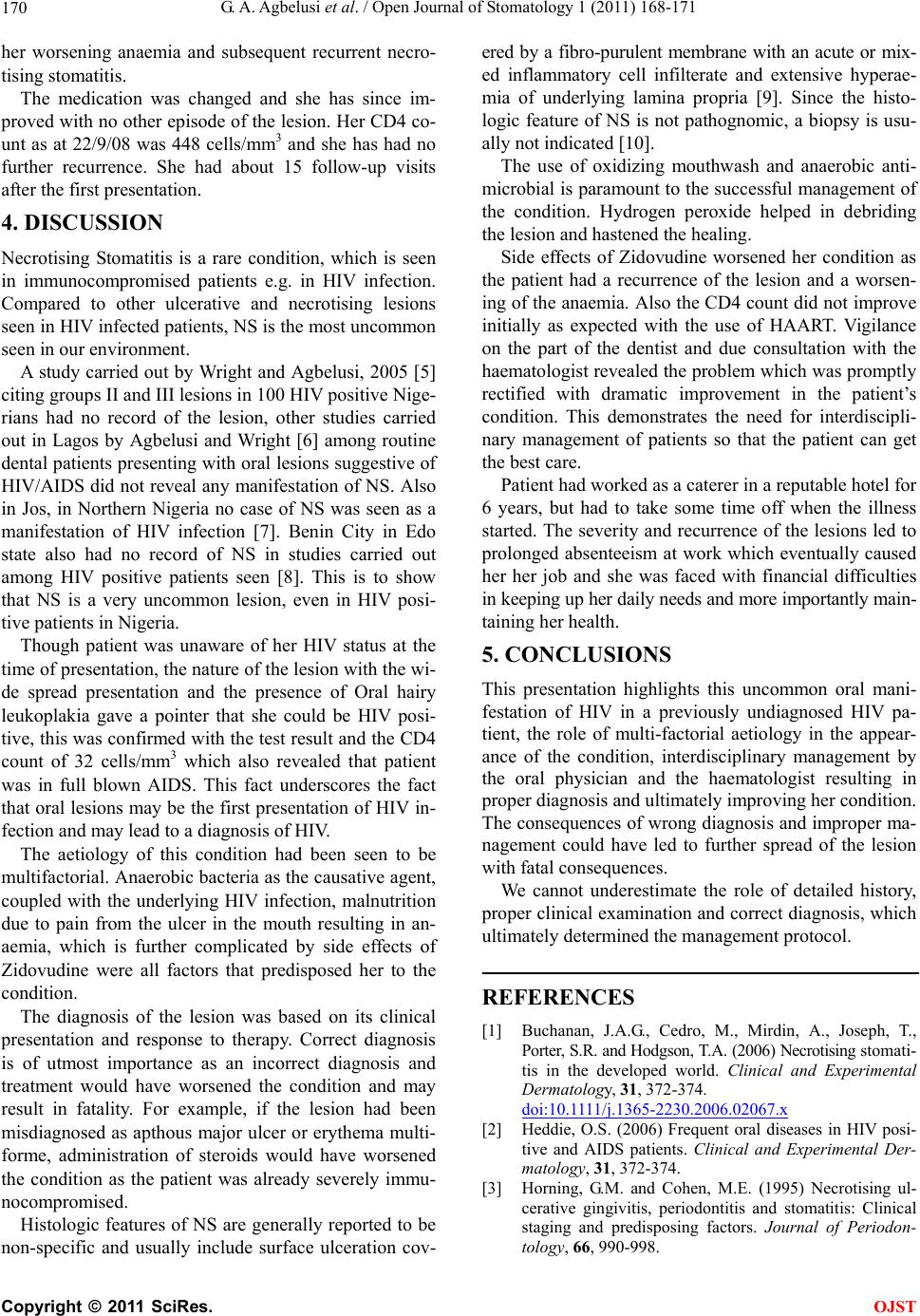
G. A. Agbelusi et al. / Open Journal of Stomatology 1 (2011) 168-171
170
her worsening anaemia and subsequent recurrent necro-
tising stomatitis.
The medication was changed and she has since im-
proved with no other episode of the lesion. Her CD4 co-
unt as at 22/9/08 was 448 cells/mm3 and she has had no
further recurrence. She had about 15 follow-up visits
after the first presentation.
4. DISCUSSION
Necrotising Stomatitis is a rare condition, which is seen
in immunocompromised patients e.g. in HIV infection.
Compared to other ulcerative and necrotising lesions
seen in HIV infected patients, NS is the most uncommon
seen in our environment.
A study carried out by Wright and Agbelusi, 2005 [5]
citing groups II and III lesions in 100 HIV positive Nige-
rians had no record of the lesion, other studies carried
out in Lagos by Agbelusi and Wright [6] among routine
dental patients presenting with oral lesions suggestive of
HIV/AIDS did not reveal any manifestation of NS. Also
in Jos, in Northern Nigeria no case of NS was seen as a
manifestation of HIV infection [7]. Benin City in Edo
state also had no record of NS in studies carried out
among HIV positive patients seen [8]. This is to show
that NS is a very uncommon lesion, even in HIV posi-
tive patients in Nigeria.
Though patient was unaware of her HIV status at the
time of presentation , the nature o f the lesion with the wi-
de spread presentation and the presence of Oral hairy
leukoplakia gave a pointer that she could be HIV posi-
tive, this was confirmed with the test result and the CD4
count of 32 cells/mm3 which also revealed that patient
was in full blown AIDS. This fact underscores the fact
that oral lesions may be the first presentation of HIV in-
fection and may lead to a diagno s is of HIV.
The aetiology of this condition had been seen to be
multifactorial. Anaerobic bacteria as the causative agent,
coupled with the underlying HIV infection, malnutrition
due to pain from the ulcer in the mouth resulting in an-
aemia, which is further complicated by side effects of
Zidovudine were all factors that predisposed her to the
condition.
The diagnosis of the lesion was based on its clinical
presentation and response to therapy. Correct diagnosis
is of utmost importance as an incorrect diagnosis and
treatment would have worsened the condition and may
result in fatality. For example, if the lesion had been
misdiagnosed as apthous major ulcer or erythema multi-
forme, administration of steroids would have worsened
the condition as the patient was already severely immu-
nocompromised.
Histologic features of NS are generally reported to be
non-specific and usually include surface ulceration cov-
ered by a fibro-purulent membrane with an acute or mix-
ed inflammatory cell infilterate and extensive hyperae-
mia of underlying lamina propria [9]. Since the histo-
logic feature of NS is not pathognomic, a biopsy is usu-
ally not indicated [10].
The use of oxidizing mouthwash and anaerobic anti-
microbial is paramount to the successful management of
the condition. Hydrogen peroxide helped in debriding
the lesion and hastened the healing.
Side effects of Zidovudine worsened her condition as
the patient had a recurrence of the lesion and a worsen-
ing of the anaemia. Also the CD4 count did not improve
initially as expected with the use of HAART. Vigilance
on the part of the dentist and due consultation with the
haematologist revealed the problem which was promptly
rectified with dramatic improvement in the patient’s
condition. This demonstrates the need for interdiscipli-
nary management of patients so that the patient can get
the best care.
Patient had worked as a caterer in a reputable hotel for
6 years, but had to take some time off when the illness
started. The severity and recurrence of the lesions led to
prolonged absenteeism at work which eventually caused
her her job and she was faced with financial difficulties
in keeping up her daily needs and more importantly main-
taining her health.
5. CONCLUSIONS
This presentation highlights this uncommon oral mani-
festation of HIV in a previously undiagnosed HIV pa-
tient, the role of multi-factorial aetiology in the appear-
ance of the condition, interdisciplinary management by
the oral physician and the haematologist resulting in
proper diagnosis and ulti mately i mpro ving her co nditio n.
The consequences of wrong diagnosis and improper ma-
nagement could have led to further spread of the lesion
with fatal consequences.
We cannot underestimate the role of detailed history,
proper clinical examination and correct diagnosis, which
ultimately determined the management protocol.
REFERENCES
[1] Buchanan, J.A.G., Cedro, M., Mirdin, A., Joseph, T.,
Porter, S.R. and Hodgson, T.A. (2006) Necrotising sto ma ti -
tis in the developed world. Clinical and Experimental
Dermatology, 31, 372-374.
doi:1 0.1111/j.1365-2230.2006.02067.x
[2] Heddie, O.S. (2006) Frequent oral diseases in HIV posi-
tive and AIDS patients. Clinical and Experimental Der-
matology, 31, 372-374.
[3] Horning, G.M. and Cohen, M.E. (1995) Necrotising ul-
cerative gingivitis, periodontitis and stomatitis: Clinical
staging and predisposing factors. Journal of Periodon-
tology, 66, 990-998.
C
opyright © 2011 SciRes. OJST